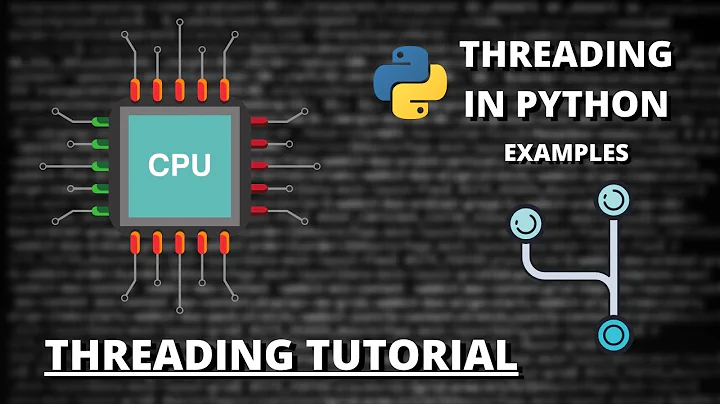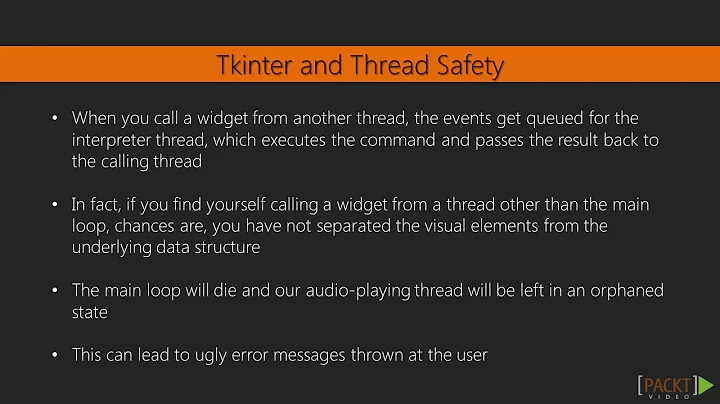Threads and tkinter
All Tcl commands need to originate from the same thread. Due to tkinter's
dependence on Tcl, it's generally necessary to make all tkinter gui statements
originate from the same thread. The problem occurs because
mainWindow is instantiated in the tkinterGui thread, but -- because mainWindow is an attribute of tkinterGui -- is not destroyed until tkinterGui is destroyed in the main thread.
The problem can be avoided by not making mainWindow an attribute of tkinterGui
-- i.e. changing self.mainWindow to mainWindow. This allows mainWindow to be destroyed when the run method ends in the tkinterGui thread. However, often you can avoid threads entirely by using mainWindow.after calls instead:
import time, threading
from tkinter import *
from tkinter import messagebox
def infinite_process():
print("Infinite Loop")
mainWindow.after(3000, infinite_process)
mainWindow = Tk()
mainWindow.geometry("200x200")
mainWindow.title("My GUI Title")
lbCommand = Label(mainWindow, text="Hello world", font=("Courier New", 16)).place(x=20, y=20)
mainWindow.after(3000, infinite_process)
mainWindow.mainloop()
If you want to define the GUI inside a class, you can still do so:
import time, threading
from tkinter import *
from tkinter import messagebox
class App(object):
def __init__(self, master):
master.geometry("200x200")
master.title("My GUI Title")
lbCommand = Label(master, text="Hello world",
font=("Courier New", 16)).place(x=20, y=20)
def tkinterGui():
global finish
mainWindow = Tk()
app = App(mainWindow)
mainWindow.mainloop()
#When the GUI is closed we set finish to "True"
finish = True
def InfiniteProcess():
while not finish:
print("Infinite Loop")
time.sleep(3)
finish = False
GUI = threading.Thread(target=tkinterGui)
GUI.start()
Process = threading.Thread(target=InfiniteProcess)
Process.start()
GUI.join()
Process.join()
or even simpler, just use the main thread to run the GUI mainloop:
import time, threading
from tkinter import *
from tkinter import messagebox
class App(object):
def __init__(self, master):
master.geometry("200x200")
master.title("My GUI Title")
lbCommand = Label(master, text="Hello world",
font=("Courier New", 16)).place(x=20, y=20)
def InfiniteProcess():
while not finish:
print("Infinite Loop")
time.sleep(3)
finish = False
Process = threading.Thread(target=InfiniteProcess)
Process.start()
mainWindow = Tk()
app = App(mainWindow)
mainWindow.mainloop()
#When the GUI is closed we set finish to "True"
finish = True
Process.join()
Related videos on Youtube
Martin DLF
Updated on June 01, 2022Comments
-
Martin DLF almost 2 years
I've heard that threads in Python are not easy to handle and they become more tangled with tkinter.
I have the following problem. I have two classes, one for the GUI and another for an infinite process. First, I start the GUI class and then the infinite process' class. I want that when you close the GUI, it also finishes the infinite process and the program ends.
A simplified version of the code is the following:
import time, threading from tkinter import * from tkinter import messagebox finish = False class tkinterGUI(threading.Thread): def __init__(self): threading.Thread.__init__(self) def run(self): global finish #Main Window self.mainWindow = Tk() self.mainWindow.geometry("200x200") self.mainWindow.title("My GUI Title") #Label lbCommand = Label(self.mainWindow, text="Hello world", font=("Courier New", 16)).place(x=20, y=20) #Start self.mainWindow.mainloop() #When the GUI is closed we set finish to "True" finish = True class InfiniteProcess(threading.Thread): def __init__(self): threading.Thread.__init__(self) def run(self): global finish while not finish: print("Infinite Loop") time.sleep(3) GUI = tkinterGUI() GUI.start() Process = InfiniteProcess() Process.start()When I click in the close button (in the upper right corner) the following error appears in the console:
Tcl_AsyncDelete: async handler deleted by the wrong threadI don't know why it happens or what it means.
-
 mguijarr over 9 yearsYour simplified version works ok for me... There must be something you forgot to add that is causing your problem
mguijarr over 9 yearsYour simplified version works ok for me... There must be something you forgot to add that is causing your problem -
Martin DLF over 9 years@mguijarr I read in google that this error is more common in Window, what's your SO? Mine is Windows 7 x64. Maybe windows is the problem :/
-
-
Martin DLF over 9 yearsThanks you a lot! You are a master!
-
Martin DLF over 9 yearsBut sometimes you NEED to make mainWindow as an attribute, for example, if you want to use: self.mainWindow.protocol("WM_DELETE_WINDOW", self.quit) When you define the function quit() and you write: self.mainWindow.destroy() self.mainWindow.quit() mainWindow must be an attribute, otherwise the function quit won't recognize mainWindow.
-
unutbu over 9 yearsYou can still use a class; just don't make the instance an attribute of the
threading.Thread. I've added some code above to suggest how. -
Donal Fellows over 9 yearsStrictly, Tcl can do multithreading and Tk can too (provided they're built with the right options) but you've got to keep an entire context per thread. The threading model is totally different to that of Python — it's much more like having a separate OS process — though that does mean that Tcl uses global locks far more sparingly.
-
Russell Smith about 7 yearsthis doesn't seem to be a universal solution. I have code exhibiting this same problem (Tcl_AsyncDelete error) and adding
mainWindow.quit()aftermainWindow.mainloop()has no effect. -
jez over 6 years@BryanOakley yep, same issue: in trying to avoid Tcl_AsyncDelete I have found
.quit()unnecessary on Python 2.7.14, and ineffective on Python 3.6.3. Haven't got a solution yet.





